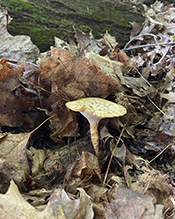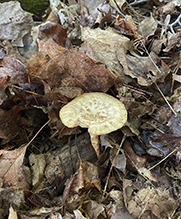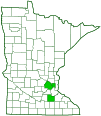Tuberous Polypore
(Polyporus tuberaster)
Conservation • Description • Habitat • Ecology • Distribution • Taxonomy
Conservation Status |
|
|||||||
| IUCN Red List | not listed |
|||||||
| NatureServe | not listed |
|||||||
| Minnesota | not listed |
|||||||
Description |
||
Tuberous Polypore is an uncommon bracket fungus. From a distance it can be mistaken for a gilled mushroom. It occurs in Europe, western Asia, Japan, and the Americas. It occurs across the United States where it is most abundant but not common west of the Rocky Mountains, and is widely scattered and uncommon elsewhere. It is uncommon in Minnesota. It is found in the spring and fall in deciduous and mixed woodlands. It grows on the ground, on wood, and on wood buried in the ground. When on the ground it often appears in groups of two or three. When on wood it usually appears alone. When it first appears, the cap is convex when viewed from the side and round, not bracket-shaped, when viewed from above. The upper surface is dry and tan to brown or yellowish-brown. The margins are curved under. As it ages it becomes flat with a depressed center or with a raised bump in the center (umbonate). The mature cap is 1½″ to 6″ (4 to 15 cm) in diameter, 3⁄16″ to ⅜″ (5 to 10 mm) thick, funnel-shaped, and darker, sometimes dark orangish-brown. The upper surface is covered with dark fibers (fibrils) and scales. The scales often have erect tips. The margins are sometimes curved upward and are often indented or lobed. The stalk is solid, tough, 1″ to 4″ (2.5 to 10 cm) long, and ⅜″ to 1″ (1 to 2.5 cm) thick, sometimes thicker. It may be attached centrally, off-centered, or sometimes at one side. When growing on the ground it is attached to a large underground sclerotium-like tuber. When on wood it sometimes has a connection through the wood to an underground tuber. A sclerotium is a hard mass of mycelium that contains food reserves and can remain dormant for long periods. The sclerotium of one mushroom was used by American Indians as a food source. The sclerotium-like tuber of Tuberous Polypore also stores food reserves, but it contains sand and dirt and is not edible. It is dark brown to black and is irregularly shaped. The pore surface is white to pale tan. There are 1 to 3 pores per millimeter. The tubes are 1⁄32″to ⅛″ (1 to 3 mm) long. The pore surface usually runs down the stalk. The flesh is pale and thin. It is edible when young and fresh after being thoroughly cooked. On older specimens the flesh is hard, tough, and inedible. The spore print is white. |
||
Similar Species |
||
Habitat and Hosts |
||
|
||
Ecology |
||
Season |
||
Spring and fall |
||
Distribution |
||||
|
Sources |
|||
| 12/7/2022 | ||||
Occurrence |
||||
Uncommon in Minnesota |
||||
Taxonomy |
|||
| Kingdom | Fungi (Fungi) | ||
| Subkingdom | Dikarya | ||
| Phylum | Basidiomycota (Basidiomycete Fungi) | ||
| Subphylum | Agaricomycotina (Higher Basidiomycetes) | ||
| Class | Agaricomycetes (Mushrooms, Bracket Fungi, Puffballs, and Allies) | ||
| Subclass | incertae sedis (uncertain placement) | ||
| Order | Polyporales (shelf fungi) | ||
| Family | Polyporaceae (bracket fungi) | ||
| Genus | Polyporus | ||
Synonyms |
|||
Boletus tuberaster Favolus boucheanus Melanopus coronatus Polyporellus tuberaster Polyporus boucheanus Polyporus coronatus Polyporus floccipes Polyporus forquignonii Polyporus lentus |
|||
Common Names |
|||
Stone Fungus Tuberous Polypore |
|||
Glossary
Umbonate
On mushrooms, having a distinct, raised, knob-like projection in the center of the cap.
Visitor Photos |
|||||
Share your photo of this fungus. |
|||||
| This button not working for you? Simply email us at info@MinnesotaSeasons.com. Attach one or more photos and, if you like, a caption. |
|||||
Honey Fae (Farah) |
|||||
 |
 |
||||
MinnesotaSeasons.com Photos |
|||||
|
|||||

Slideshows |
||

Visitor Videos |
|||
Share your video of this fungus. |
|||
| This button not working for you? Simply email us at info@MinnesotaSeasons.com. Attach a video, a YouTube link, or a cloud storage link. |
|||
Other Videos |
|||
| Polyporus tuberaster - Tuberous Polypore The wonderful world of mycology |
|||
About
Jun 14, 2022 I have already uploaded a video of this species, but in April I found a very nice sprout on a possibly oak trunk and was able to track the growth of this fungus. One of the first to grow in spring and that I see with some frequency. It is not poisonous but its leathery meat takes away all the culinary possibilities I also share the images of some horses with their foals on a sunny day, where suddenly the fog was made. It is what the mountain has, even with fog it gives us these images to enjoy the day. Characteristic: |
|||
| Polyporus tuberaster (Tuberous Polypore) Find In Nature - mycology, fungi |
|||
About
Dec 7, 2020 Found 7 mushrooms of Tuberous Polypore (Polyporus tuberaster) growing on wood. Some authors refer bigger spores for Polyporus lentus over Polyporus tuberaster, and that, while the former grow on wood without a sclerotium, the latter grow on the ground and from a sclerotium. The mushrooms that I found were growing on wood and have spores that go up to 19 µm. So, in that sense it would be Polyporus lentus. However, I think that currently P.lentus and P.tuberaster are considered to be synonyms. Moreover, back in 2018, in that same place, I found 2 specimens on the ground growing from what seemed to be its sclerotium, which reinforces the idea that lentus and tuberaster are the same species. Sclerotium is an underground blackish potato-like tuber from which the mushrooms emerge, that is thought to be a resting stage structure, used for storage of essential food substances necessary for the fungi to survive harsh periods. Polyporus lentus is also synonimized with Polyporus forquignonii. Polyporus tuberaster is edible when specimens are very young. |
|||

Created: 12/7/2022
Last Updated:


